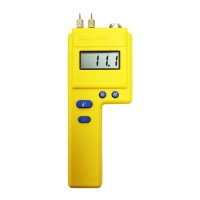6
USING THE 0 -100 ARBITRARY SCALE
This scale is used to test the moisture content of hygroscopic materials for which a calibration is not
available. Depending on the material, a special application external electrode, instead of the integral
contact pins may be required. Increasing readings on the 0-100 reference scale indicate higher levels of
moisture content. These readings can be translated into percent rnoisture content once a calibration has
been developed.
Set the meter scale for #2. lf necessary, attach an external electrode to the meter.
Push the contact pins into the material or apply the external electrode,
Press the read button (#1). The meter displays a relative value for two seconds.
The readings may also be used for comparative tests, after meter readings have been related to given
conditions for the materials involved. When the meter is used as a gauge for comparative tests, readings
should be taken on samples considered to be at "safe' levels or in satisfactory condition. These readings
are then used as the "standard" against which subsequent readings on the same material are evaluated.
The "standard' for any given material is related to safe storability or any other property which is
important for further production processing.
TESTING BALED SCRAP PAPER
Set the meter scale for #3 baled scrap paper. Attach an external electrode to the meter.
Push the external electrode into the material being tested
Press the read button (#1). The meter displays the %MC for two seconds.
The level of accuracy of meter readings depends on a number of factors: similarity between the material
tested and samples on which the calibration was made; moisture distribution; and chemical application or
processing which may affect the electrical properties of the paper product.
The required electrode is the H-4 with a #830-series prod. (10"or 18"). A sharp steel rod to open the
hole for the prod may be helpful if the bale is very dense.
A few meter readings in a limited number of specific areas of a large mass can hardly be projected to
indicate an average moisture content of an entire bale. The readings can be very helpful in providing an
indication of the overall moisture condition inside the bale and to detect areas of excessive moisture.
Meter readings may be used as an arbitrary guideline in determining whether or not to accept or reject
the material. Since checking the moisture condition of bales is performed when buying and selling, the
specific value of the meter readings remains an element to be agreed upon between buyer and seller.
Such an agreement should consider not only a specific "range" of readings, but the number and location
of where they are taken.
The following ranges can be used as a guideline and may help to interpret the readings:
Readings of 5% -10%, with EMC to 60% RH are usually considered "dry".
Readings from 11% -20% with EMC to 95% are usually considered as acceptable" but should be
taken with some reservation.
Readings of 20% -40% are considered "wet" and unacceptable.

